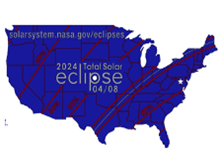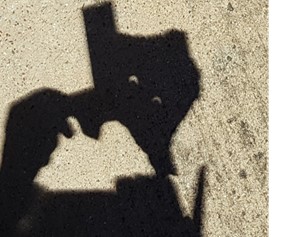How did you observe the Great American Eclipse of 2017? Were you looking up, or collecting data from down on the ground?
If you recall, on August 21, 2017, there was an enormous amount of excitement in schools, universities and local communities especially along its path of totality. August 21, 2017, was the first time a total eclipse of the sun was visible in the continental United States in more than 35 years. Persons outside at midday across the US witnessed the effects of a total eclipse, while others viewed a partial eclipse. Most K-12 students in 2017 had never before witnessed a total solar eclipse.
The NASA Space Science Education Consortium (NSSEC), led by NASA’s Goddard Space Flight Center, focused educational resources on activities to support learner interest in space science and the solar eclipse, in particular. The University of North Texas (UNT) was part of NSSEC, now called HEAT (Heliophysics Education Activation Team), and created lessons and activities for middle school students involving innovative technologies, such as 3D printing, augmented reality (AR), and virtual reality (VR) to support learning. Data were collected from middle school students regarding their knowledge and attitudes toward heliophysics, space science, and the solar eclipse (Christensen & Knezek, 2023; Knezek & Christensen, 2020).
Students who attended 4-hour Space Science Technology Innovation Camps focused on the solar eclipse gained a great deal of knowledge by participating in the camps’ hands-on innovative technology activities. Students were engaged and reported enjoying the camps (Figure 1).
Figure 1
Observers With Dr. Knezek, UNT Faculty, in Texas Using Solar Eclipse Glasses

Science, technology, engineering, and mathematics (STEM) engagement best practices refined over the past 6 years were conveyed to preservice teachers in fall 2023 (Figure 2). Thousands of other young learners and adults participated in technology-infused, eclipse viewing events focusing on that day in 2017 and extending into related space science activities for years to come (Knezek et al., 2020).
Figure 2
Texas Preservice Teachers in Technology Tools for Educators Class at UNT Receiving Preparatory Eclipse Viewing Training in Fall 2023.

Once again, a Great American Eclipse for 2024 is quickly approaching this spring on April 8, 2024. How might we make this an even better learning experience for our students and communities? Several lessons were learned during the 2017 Total Solar Eclipse that can help us better prepare for the upcoming Total Solar Eclipse in 2024 (Figure 3). During the 2017 eclipse, many people went to NASA’s 2D/3D printable projector website (https://eclipse2017.nasa.gov/2d3d-printable-pinhole-projectors) to download and print pinhole image projectors. Many also purchased eclipse glasses from NASA-certified, ISO 12312-2:2105 compliant vendors.
Figure 3
Xavier Jubier Eclipse Map Showing Locations of the 2017 and 2024 Total Solar Eclipses Across the US.

As we gear up for the spring 2024 event, several avenues have emerged for K-12 educators to secure materials for guided eclipse viewing activities with their students, including small grants providing educator funding. Also, educators should have the following websites on the 2024 eclipse bookmarked: American Astronomical Society (AAS; https://eclipse.aas.org/) and National Aeronautics and Space Administration (NASA; https://science.nasa.gov/eclipses/).
Many readers will have also experienced the October 14, 2023 Annular Eclipse (moon obscures sun but “a ring of fire” remains, so total darkness does not occur) that transited the US from Oregon to Texas (Figure 4). This event created a rare opportunity for many viewers to experience a warmup event 6 months before the Total Solar Eclipse crossing from Texas to Maine on April 8, 2024.
Figure 4
NASA Eclipse Map Showing Where the Moon’s Shadow Crosses the US During the October 14, 2023, Annular Solar Eclipse and the April 8, 2024, Total Solar Eclipse

Curriculum and Activities
Both AAS and NASA eclipse are remarkable key resources to start preparing for the event. The websites have information related to the planning workshops, the path of totality, safety, royalty-free images, books, and curricula. The NASA STEM Learning resource (https://mynasadata.larc.nasa.gov/phenomenon/solar-eclipse) makes full sensory experiences, as well as mini lesson plans (https://mynasadata.larc.nasa.gov/mini-lessonactivity/what-solar-eclipse) for educators.
If you are a science educator with a membership to the National Science Teaching Association (NSTA), you will be able to watch an archived video called, Safe Solar Eclipse Viewing Techniques and What School Administrators Need to Know, (https://my.nsta.org/resource/127966/archive-safe-solar-eclipse-viewing-techniques-and-what-school-administrators-nee), which was recorded during September 2023. NSTA also has guides for teachers and administrators. One picture book that should be on every teacher’s desk is NSTA’s When the Sun Goes Dark by Andrew Fraknoi and Dennis Schatz. This book is an easy read and has some great illustrations to help prepare for the upcoming event. Some educators may also leverage YouTube and find lessons to replicate, like Scaling a Solar Eclipse (https://www.youtube.com/watch?v=0IYCoQkMZAE), created by Purdue University.
Safety Issues Observing the Eclipse
Numerous potential eyesight damage safety concerns were voiced by school districts during the eclipse of 2017. Collectively, the 2017 eclipse and the October 2023 eclipse have informed educators how to best prepare for the next big eclipse. We are better positioned now to address some of the safety concerns for the 2024 eclipse. One of the things that we can do as educators in our various contexts is to start our preparation early. Specific recommendations are provided in the sections that follow.
Determining Optimum Viewing Times at Your Location
The NASA map shown in Figure 4 contains eclipse totality times printed in local time zones (Central vs. Eastern time, for example). Viewers can estimate the time at which the maximum eclipse intensity will occur at their location by drawing a line from their location perpendicular to the Path of Totality in Figure 4. A very high-resolution version of this map is available from NASA (https://svs.gsfc.nasa.gov/5073). For those on or near the path of totality, the increasing-toward-totality stages of partial eclipse will be noticeable approximately 1 hour before totality and will end approximately 1 hour after totality.
The greatest duration of totality is a bit more than 4 minutes for those along the center line of totality (blue line) in Figure 3. The width of the path of totality is now generally reported to be up to 115 miles. However, any other viewers within the 100-mile-wide path of totality (wide black line in Figure 4) will have a total solar eclipse experience just as rich as those on the centerline, with the major difference being that the duration of totality becomes shorter (2 minutes vs. 4, for example) as one moves toward the edge of the Path of Totality detailed in Figure 4. This can be especially useful for planning STEM enjoyment/engagement activities at an individual K-12 school, university, home backyard, or any other prospective viewing site.
The interactive eclipse simulation maps produced by Xavier Jubier (http://xjubier.free.fr/en/site_pages/solar_eclipses/TSE_2024_GoogleMapFull.html; e.g. Figure 3) are highly regarded worldwide for ease of use in locating the exact times of totality beginning and ending, or maximum intensity times outside the path of totality, for any location along the path of an eclipse. A user begins with a view of a map similar to the one in Figure 4 and then clicks the familiar “+” button to zoom in and navigate with a mouse cursor to the precise location desired in this Google Maps overlay for 2024. Then by clicking on the desired location (school, park, or home), a pop-up window will appear to tell the precise times of partial and/or total eclipse beginning and ending in Universal Time Coordinates (UTC or Greenwich Mean Time). One last step is to convert (via Google, etc.) the difference between one’s local time and UTC. For example, 1:30 p.m. (13:30) in Dallas, Texas, will be listed as UTC 18:30 (+5hrs.) in April 2024.
Safely Viewing a Solar Eclipse
There are many ways to make observations of the solar eclipse with objects. Two of the most popular ways will be using eclipse glasses and pinhole projectors. There are several avenues to secure a pair of eclipse glasses. One of the recommendations is to check with your local public library since the Solar Eclipse Activities for Libraries (SEAL; https://www.starnetlibraries.org/about/our-projects/solar-eclipse-activities-libraries-seal/) has 10,000 libraries prepared.
Inevitably, there won’t be enough glasses for everyone, so having alternate plans is imperative. One avenue is to tap your local university. For example, UNT in Denton, Texas, has contributed over 2,500 eclipse glasses to the pool of resources provided by the National Science Foundation, NASA, the University of Texas at San Antonio, and McDonald Observatory for the October 2023 and April 2024 events. Materials were delivered by the La Frontera Mobile STEM Van (www.sulross.edu/lafrontera/) and the Institute for the Integration of Technology into Teaching and Learning at UNT (http://iittl.unt.edu) to school district sites such as Eagle Pass, Carizzo Springs, Del Rio, El Dorado, Ft. Worth Trimble Tech, Knippa, Sacred Hearts Uvalde, Sanger Middle School, Sequin Schools and Uvalde Christian Academy. UNT is already working with NASA HEAT, source of the pinhole eclipse map (Pat Haas), and are preparing for the anticipated crowd of 10,000 at Dallas Arboretum for Totality on April 8.
Also, a pinhole projector can be printed locally if you have access to a 3D printer, as seen in Figure 5 from the 2017 Indiana University Southeast event with an Indiana State red pinhole projector. The STL files can be easily accessed through the NASA Pinhole Projector link (https://www.cadlibrary.org/objects/V3DKUZB0) on the Objects to Think With CAD Library for the NASA pinhole projector for the April 2024 eclipse (Figure 6). The CAD library (https://www.cadlibrary.org/) is a recently created free resource that can be used by educators to complement teaching concepts. This curated resource has vetted materials that can be 3D printed and can cover a vast array of content areas.
Figure 5
Faculty Members From Indiana University Southeast Gathering on Campus for the Event Ready With Pinhole Projector in the Shape of Indiana

Figure 6
3D Printed NASA Pinhole Projector for Safely Viewing Images of the April 2024 Solar Eclipse on the Ground

For those without 3D printing capabilities, a card stock version of the NASA pinhole projector/eclipse path map can be downloaded. Past experience indicates these functional mementos will be retained as souvenirs by viewers for years to come (Figures 7 and 8). Very simple household items can also be used to make highly engaging pinhole projectors for viewing partial eclipse stages. For example, a colander makes a fascinating array of clear half-moon-shaped solar images on the ground, similar to tree leaf projectors, such as the naturally-occurring pinholes in oak trees. One simple pinhole projector fabrication activity has been provided by NASA JPL in California (https://www.jpl.nasa.gov/edu/learn/project/how-to-make-a-pinhole-camera/).
Figure 7
Image Captured Using a 3D Printed Pinhole Camera During 2017

Figure 8
Image Captured Using a 3D Printed Pinhole Camera During 2023

Considerations for Students with Visual Impairments
Many versions of simple pinhole projectors are available to add richness to the eclipse viewing experiences of those with or without eclipse shades (glasses) or other higher-technology affordances. Viewers may find their local site experience is greatly enhanced by having a laptop display connected to a live “play-by-play” eclipse streaming site, such as NASA TV. This becomes especially important if your local site happens to be cloudy on April 8, or other circumstances (such as young school children not being allowed outside during an eclipse) prevent some segments of society from venturing outdoors.
Students who are blind or visually impaired (BVI) share this interest (Martin et al, 2011). Space can motivate students who are BVI to learn fundamental scientific and critical thinking skills. Student experiences and interests often lead to careers in STEM. Students who are BVI are underrepresented in STEM careers (Beck-Winchatz & Riccobono, 2008). This critical opportunity to experience the eclipse could encourage all students, including students who are BVI, to pursue a STEM career. Because of the novelty and popularity of the solar eclipse, students who are BVI seek participation. Adaptive devices and materials can enhance the eclipse experience.
As early as 2008, NASA provided braille books explaining the eclipse. More recently, sophisticated apps have been developed. One example of an adaptive technology resource that can be used by anyone is NASA’s Eclipse Soundscapes Project. Soundscapes was originally developed to give individuals with BVI as an immersive auditory experience for the 2017 Total Eclipse. This application has been further refined and used at several sites across the nation for the 2023 Annular Eclipse.
The Soundscapes curriculum can provide a richer total eclipse experience by focusing on the massive changes in the sounds of the animals and insects during the eclipse rather than only on the disappearance of sunlight. Dr. Jennifer Miller of Sul Ross State University successfully implemented the Soundscapes NASA curriculum with Noyce preservice teachers and mentor teachers from Sul Ross State University and Southwest Texas State College. This training provides future teachers and other participants the opportunity to become a data analyst or observer and record eclipse events. Training future teachers should have a trickle-down effect so they will be able to use adaptive resources with their future students with and without disabilities.”
Looking Forward to Objects to Think With as Resource
Students in elementary, middle, and high school are naturally interested in space. This editorial shares resources to help facilitate preparation for the April 8, 2024, Total Solar Eclipse. Science educators can complement teaching and learning experiences through the use of educational technology like 3D printed materials, augmented reality, virtual reality, and websites (Asim et al., 2022). The Objects to Think With section in CITE Journal (https://citejournal.org/category/objects-to-think-with/) will be a resource to expand the pedagogical toolbox for all educators across content areas.
References
Asim, S., Ellis, J., Trumble, J. & Slykhuis, D. (2022). Three domains for technology integration in science teacher education. Contemporary Issues in Teacher Education, 22(2), 664-684.
Beck-Winchatz, B., & Riccobono, M. (2008). Advancing participation of blind students in Science, Technology, Engineering, and Math. Advances in Space Research, 42, 1855–1858. https://doi.org/10.1016/j.asr.2007.05.080
Christensen, R. & Knezek, G. (2023). Impact of space science innovative technology activities on middle school student groups underrepresented in STEM. Journal of Computers in Mathematics and Science Teaching, 41(4), 1-30.
Knezek, G., & Christensen, R. (2020). Researching impact: Measuring technology enhanced outcomes from the NASA Space Science Education Consortium. Journal of Computers in Mathematics and Science Teaching, 39(4), 399-420.
Knezek, G., Christensen, R., & Ng, C. (2020). Inspiring STEM engagement: Space science education in the 21st century. Journal of Computers in Mathematics and Science Teaching, 39(4), 285-290.
Martin, J. K., Stumbo, N. J., Martin, L. G., Collins, K. D., Hedrick, B. N., Nordstrom, D., & Peterson, M. (2011). Recruitment of Students with Disabilities: Exploration of Science, Technology, Engineering, Mathematics. Journal of Postsecondary Education and Disability, 24(4), 285–299.
![]()